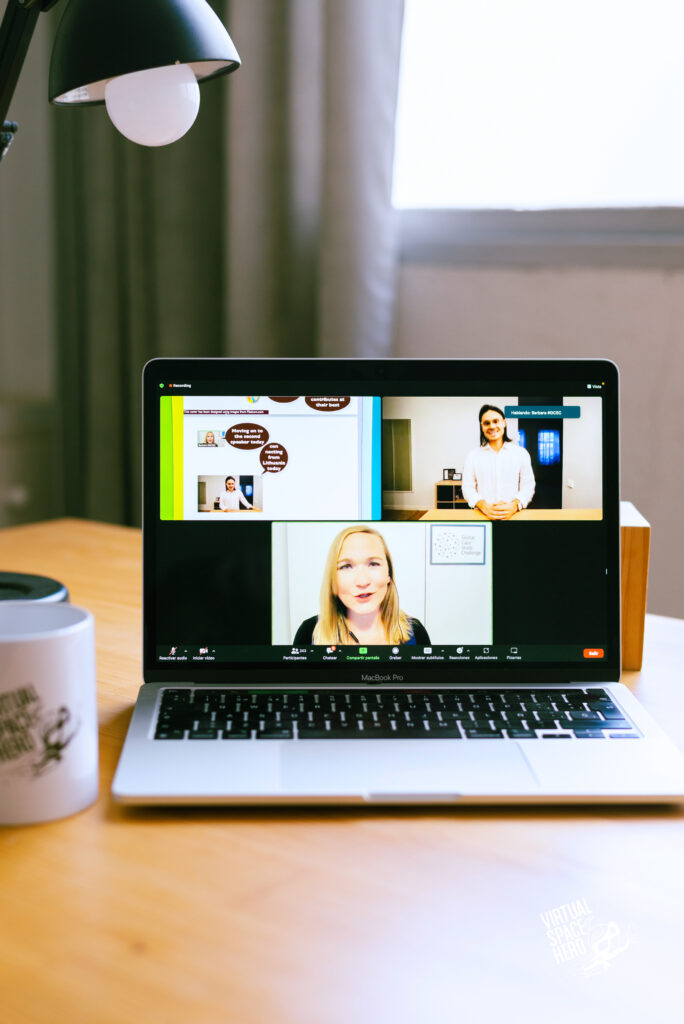Virtually all projections anticipate the post-pandemic workforce will be relatively more remote — that is, nearly all firms will experience an increase in remote work relative to their pre-pandemic baseline levels (HBR 2021). An estimated 55 million meetings occur a day. Sadly, research suggests only around 50% of meeting time is effective and engaging. Unfortunately, these effectiveness numbers drop lower when it comes to virtual meetings (Rogelberg 2020).
This blog article recaps the most important points from a LinkedIn Interview with the Remote Work and Training Expert Nancy Settle-Murphy from Guided Insights.
What are the essentials when preparing an engaging virtual meeting?
Organizing a meeting that is engaging while also making sure that its objectives will be reached is always hard. In the virtual space, this struggle is present even more. Barbara and Nancy discussed different techniques on how to keep virtual meetings engaging and effective at the same time:
❌ Do not start with the technology aspects. Usually, we like deciding on all technological aspects first and then planning the meeting around that. However, 3 things need to be considered before the technology can be chosen.
1. What are the objectives and the intended outcome of the meeting?
2. What kind of conversation(s) are needed to achieve those objectives?
3. Is the topic likely to be contentious, or is there a large emotional component?
These aspects will determine the length of the meeting, as well as the activities that need to be incorporated into it.
✅ Preparation of everyone involved is key. The participants must be adequately prepared when they join the meeting and know what will be going on. One way of ensuring that is sending out a general agenda beforehand (agendas and how to write them will be discussed in more detail in the following section), as well as letting everyone know what they are expected to prepare and how they are expected to prepare it. As people might not read the attachments of the e-mails they are sent, it is important to ask for confirmation and/or feedback if the expected preparation activities were understood and if they will be done on time. Another aspect that can “change the game” is to formulate questions rather than agenda items.
✅ Choose the right technology. When it comes to choosing the right meeting platform, many details need to be kept in mind. The two main necessary considerations are:
- To what extent do the participant´s ideas/contributions need to be preserved? If they need to be savable and/or re-readable, it will probably not work to have the participants write everything in the chat, for example. Maybe a tool such as jamboard, miro or any other platform where to capture the brainstorming might work better.
- Can your participants access the platforms/tools, and if not what alternatives can you offer them? Technological and/or environmental differences and physical ability might keep certain participants from participating in some activities. If possible try to find alternative ways of involving them already beforehand. A thorough onboarding to the platform is important, for example sending out a video with instructions on how to use the platform itself with the main features or opening up the room 15 mins ahead for those who would like to run a quick tech check.

“Many people say that virtual meetings need to be kept relatively short, and generally this is true. We have a very short attention span, and after a while, people will start to multitask and look at their phones. At the same time, if we need and deserve a full-blown discussion with an exchange of ideas, we cannot just plan for the meeting to be only one hour long.”


How should we create an agenda to drive success?
Any agenda should consist of the following 4 points.
✔️ Agenda items preferably in the form of a question (e.g. What are the biggest challenges that the Finance department is facing at the moment?)
✔️ Timeframes for the discussion of each point. If you plan on sending out the agenda beforehand, which is strongly advised as it means that everyone will be better prepared, the timeframes for each activity should be left out as it would create stress for the participants to know that they are behind on the allocated time for an activity.
✔️ Objective for each agenda item (e.g. Find ideas for possible solutions to the biggest challenges the Finance department is facing at the moment)
✔️ Possibility of engagement for the participants related to every topic (e.g. brainstorming, discussion, asking them to raise their hand, …)
The agenda should be as detailed as possible and leave room for interaction opportunities every 5 to 7 minutes. They can be as small as asking the participants to raise their hand if they understood the question, or be more intense like asking them to contribute to a word cloud or collaborating in a breakout room. Formulating the items on the agenda in the form of a question will help to engage the participants right from the start. Ideally, everyone will contribute an answer to the posed question, which can stimulate discussion and the exchange of ideas.



Whom should we invite and how long should the meetings be maximum?
Generally, the smaller the number of participants, the higher the efficiency of the meeting. Meaning, that only those that are needed there to reach the objective should take part in the meeting. For some, it might be also enough to get the information in an asynchronous way afterwards. Furthermore, meetings about a certain topic might be splittable into different, smaller group conversations. For example, people working on a specific project can have smaller meetings amongst them if the discussed topics only concern them. There is no need to always invite the whole department of the region that the project is carried out in. Where this is possible, do it to avoid meetings with more participants than needed. In some cases, the input or ideas of certain people can be collected before the meeting. This can also reduce the number of actual participants in the real-time meeting.




What do we need to consider when facilitating a virtual meeting so that everyone feels included in the discussion?
One of the questions we are getting almost on a daily basis is “How do I get the meeting off to a good start?”. Why? Because the way you are starting the meeting will set the mood for the entirety of it. There are some little tricks that you can use to engage the participants right from the start.
“We often forget about the informal check-in at the beginning and jump right into the topics because we are so task-driven when it comes to virtual work. It is much better in my opinion not to show any slides or any other content via screen sharing at the beginning of the meeting so that we can all see each other. Use a fun icebreaker to kick-off with some laughs and then start the discussion around the topic.” (Barbara Covarrubias Venegas)
✅ Ask people to come on a few minutes early so they can test their audio and video and the rest of the technology as well as greet each other informally.
✅ The meeting has to start passionately and emotionally, transmitting a lot of energy to get the people to really be present in the meeting.
✅ As people come online, greet them by name.
✅ Verbally, or written in the chat, ask the participants a question that will help them connect and relax. (e.g. What new hobby did you pick up during the pandemic? Which one is your favourite season and why? …..)
✅ In meetings where personal connections are crucial for its success, put the participants in small breakout rooms of 3 or 4 already at the beginning. Once they return, they will know at least the people that they were in the breakout room with and will be more likely to talk in the bigger group.
Engagement, on the other hand, starts with people knowing what they are supposed to do.
Interactive tools like Mentimeter, Sli.do or Miro/Mural are an amazing way to keep engagement high during the meeting. However, they can only work if the participants know how to use them. Meaning that whatever tools will be used synchronously, people should familiarize themselves with them asynchronously and in advance. This can be reached by giving them exercises and/or links before the meeting, sharing a short video tutorial or even organizing a demonstration on at least 2 different dates the week before. Lastly, in the virtual space context is crucial. Giving everyone information on how or why something is happening is the only way to get everyone on the same page and have everyone know what is happening.
5 things to consider to design and facilitate inclusive conversations
When working in global virtual teams, cultural differences are inevitable. The following aspects are critical to work effectively together by creating an inclusive environment:

1️⃣ Know how proficient the participants are in the shared language. If there are one or more participants that are not proficient in the used language, plan for around 15-20% more time for paraphrasing, summarizing, and validating understanding.
2️⃣ Pause and scan for misunderstandings. A producer or co-facilitator can have an eye on the participants and let the facilitator know, in a subtle way, if something should be repeated, as the participants themselves often do not ask for repetitions.
3️⃣ Be informed about the different decision making-, and conflict resolution styles. Knowing how different cultures handle decision-making and conflicts is very important. For example, some cultures take decisions in a fast way and do not need a lot of time to reflect. Others need to consult with colleagues, family, or friends first, meaning they need more time, and you cannot force them to make fast decisions. The same is true for solving conflicts. You cannot intervene in the right way if you are not informed about the cultural differences that might influence the process.
4️⃣ Be aware of technological differences. The same technological infrastructure is not available everywhere. Be sensible and offer alternative ways of participating for those that might have technological constraints. Be it due to bandwidth or even to national restrictions on using certain web based platforms.
5️⃣ Do not leave out introverts. Introverts are often forgotten about in virtual meetings. For everyone to be able to contribute, there should be at least two communication channels. Namely, verbal contributions and the chat. Go back and forth between having the participants talk and type. Limiting verbal contributions per person allows for talking portions also in bigger meetings.
Besides, consider the rule *THINK*-*PAIR*-*SHARE*.
We know that using techniques such as Liberating Structures 1-2-4-ALL where you first encourage individual reflection *THINK* and then *PAIR* up in a 2-breakout session, 4- breakout session and *SHARE* at the end in the plenary. This is how you can ensure that the louder voices amplify the lower voices (introverts).

What needs to be considered when ending a virtual meeting?
How a meeting ends is just as important as how it is started. Following the below-mentioned steps will make sure that everybody leaves with the needed information.
1️⃣ If a meeting is going to end with actions or questions, allocate at least 5 minutes, in the end, to recap them verbally. The verbal recap is a strong buy-in as well, meaning that your participants feel more committed to the task and it is also the moment to ensure that everybody understood correctly.
2️⃣ Plan for enough time to go over at least some questions/topics/concerns that were put in the “parking lot” at the beginning of the meeting or during it. If questions/topics/concerns are brought up by the participants during the meeting, and you have promised to revisit them at the end, it is important that you actually do. If you do not, your employees or colleagues will lose their trust in you.
3️⃣ Give the participants information about what is going to happen next and about what decisions will be taken when, and in what way they will be communicated to them.
4️⃣ State the next meeting time.
5️⃣ Let everyone know where the notes can be found if they were taken.
Creating creative and engaging virtual meetings can certainly be challenging and sometimes maybe even overwhelming. So, become a #virtualspacehero, and do not miss our LinkedIn lives, blog posts or podcast to get tips and tricks that will help turn you into a virtual meeting pro!






